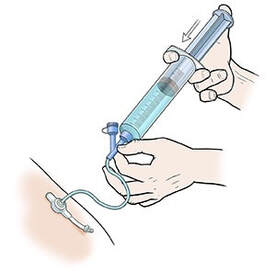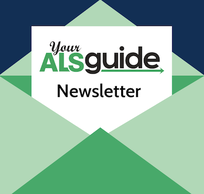Feeding Tubes for ALS |
|
|
As ALS progresses, it can become harder to eat well and stay hydrated. If you notice that you are coughing or choking on food or liquid, having trouble swallowing, getting tired while chewing, or losing weight, you may want to think about getting a feeding tube.
A feeding tube is a short, bending tube that is put straight into your stomach. A feeding tube can help you safely get the calories, nutrients, and hydration your body needs. |
What are the benefits of feeding tubes?
|
A feeding tube can help you maintain your weight, strength, and energy levels. A feeding tube can also help you stay hydrated, which can thin your saliva and make it easier to swallow saliva.
A feeding tube can lower your risk of choking or having food, liquids, or medications go down the wrong pipe (into your lungs instead of your stomach). When food, liquids or medications go down the wrong pipe, it can lead to pneumonia, which can be life-threatening for people living with ALS. |
|
Once you have a feeding tube, you can enjoy eating by mouth as long as it is still safe. Knowing that your body will already get the nutrition it needs through the feeding tube can make mealtimes more pleasurable and save you energy for other activities.
If pills and vitamins are hard to swallow, you can crush and administer them through the feeding tube as long as they are crushable. Talk with your doctor to make sure your pills are crushable or discuss other ways of taking your pills.
If pills and vitamins are hard to swallow, you can crush and administer them through the feeding tube as long as they are crushable. Talk with your doctor to make sure your pills are crushable or discuss other ways of taking your pills.
What are the downsides of feeding tubes?
A feeding tube also comes with cons. First, you must have surgery to place the tube. Surgery and anesthesia have risks, though your surgeon and medical team will try to lower these risks as much as possible. Your body may need time to get used to the feeding formula. The feeding tube site needs daily care, like washing the skin around the tube. Though not common, the skin around the tube can get infected or the tube may get pulled out. It is important to talk with your medical team first to see if a feeding tube is right for you.
What is the procedure like?
|
Placing a feeding tube is generally a safe, simple procedure that can take as little as 30 minutes. If there are no complications, you may go home the same day. You may experience mild pain and discomfort.
For people with lower breathing strength, getting anesthesia while lying down can make breathing more difficult. To minimize surgical risks and complications, it is recommended that people living with ALS have feeding tubes placed before their Forced Vital Capacity (lung strength test) falls below 50%. At the hospital or surgery center, a dietitian will show you how to use and care for your feeding tube. The dietitian will also have nutrition formula and feeding supplies ordered for you. The formula and supplies are usually covered by insurance and shipped to your home monthly. A nurse will likely visit your home shortly after your surgery to check your feeding tube and answer any questions you have. |
|
How does a feeding tube work?
|
If you can still eat safely without choking or having food or liquid go down the wrong pipe, you can use your feeding tube to supplement what you eat by mouth. As eating becomes more difficult, your feeding tube can become your primary source of nutrition.
Nutrition formula can either be poured through the tube into the stomach all at once using a syringe or delivered as a slow drip using a bag or feeding pump. Instead of using pre-made nutrition formulas, you can instead use an industrial-strength blender to liquefy homemade foods. |
|
When you are done with each feeding, the tube will need to be flushed, and the cap replaced. If you have a “button” tube, the extension set (tubing) will be disconnected and rinsed out after each use. Depending on how you deliver the feeds, the syringes or bags will need to be rinsed or thrown away. Feeding tubes can be hidden under clothing and not seen by others.
Should I get a feeding tube?
This is a personal decision that will need to be thought about in terms of your long-term goals and advance directives. Talk with your ALS clinic or local medical team about the pros and cons of getting a feeding tube.
Here are two online decision tools that can help with making this decision:
Here are two online decision tools that can help with making this decision:
We developed this page in collaboration with ALS clinical dietitian Stephanie Dobak




